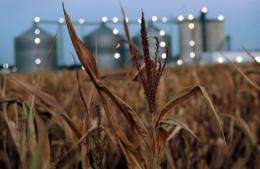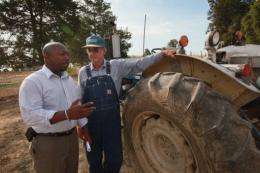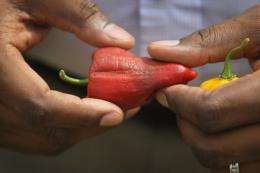A field of dead corn sits next to the Lincolnland Agri-Energy ethanol plant in Palestine, Illinois, on July 25. Two-thirds of the continental United States is now suffering from the most widespread drought since the 1950s.
The sweat pours down Larry Hasheider's face as he walks across his parched cornfields to show the result of one of the worst droughts to strike the United States in decades.
"This is the best ear I've got out here, right now. And, that's about half the normal size. The plants that are next to it produced nothing," the Illinois farmer said as he pulled the husk away to show the only spot of yellow in a field of dried-out corn stalks.
"What I'm seeing here is a total crop failure. There is no grain out here to harvest."
Two thirds of the continental United States is now suffering from the most widespread drought since the 1950s.
And the drought in America's breadbasket is intensifying at an unprecedented rate, driving concern food prices could soar if crops in the world's key producer are decimated.
The latest US Drought Monitor reported a nearly threefold increase in areas of extreme drought in the course of a single week in the nine Midwestern states where three quarters of the country's corn and soybean crops are produced.
"It's kind of like being sucker-punched in the stomach," Hasheider told AFP. "You think, 'OK, it's bad this week, but next week it can't be this way. Well, it is."
Delbert Craig (right) chats with Karis Gutter of the United States Department of Agriculture following a tour of Craig's drought-stricken farm near Goreville, Illinois, on July 26.
Hasheider is fortunate -- most of his farm is irrigated -- but officials say only about 15 percent of US cornfields are. Some rural water suppliers are talking about mandatory restrictions because they have seen such a dramatic drop in the water table.
The percentage of the nation's corn crop rated very poor or poor rose to 48 percent in the week ending July 29, while 47 percent of the soybean crop was in very poor or poor condition, according to the US Department of Agriculture.
That's the worst rating since the drought of 1988, which cut production by 20 percent and cost the economy tens of billions of dollars.
With grazing pastures also parched and feed prices at record highs, many ranchers are sending their animals to slaughter early because it's too costly to keep them until full size.
President Barack Obama's administration has opened up protected US land to help farmers and ranchers and has encouraged crop insurance companies to forgo charging interest for a month.
It has also provided emergency low-interest loans to farmers in the 1,234 counties across 31 states which have been declared disaster areas due to the drought.
Karis Gutter of the United States Department of Agriculture (USDA) looks over peppers grown on the farm of Jerry Jimenez on July 26, 2012 near Cobden, Illinois. Some rural water suppliers are talking about mandatory restrictions because they have seen such a dramatic drop in the water table.
Local governments are also trying to help. The state of Missouri has offered millions in grants to help farmers and ranchers drill or deepen wells and expand irrigation systems.
Experts predict there will still be a sizable harvest -- just not anywhere close to the bounty of recent years or the bumper crop predicted before the rain stopped.
And that will likely bring price increases for food and all types of products for years to come.
"We're not just talking about the fact that things are going to be tight here in the United States," said Sam Funk, senior economist with Doane Advisory Services.
"When you look at such a large portion of the corn and soybean crop that gets exported, you're going to talk about substantially impacting a number of other marketplaces."
The impact spreads far beyond just cereal or bread -- or a single growing season -- because so much of the US crop is used as livestock feed and those herds are being culled, Funk explained.
Due to the early culls, getting the US cattle herds back up to pre-drought levels would take at least two years, he said, warning that pork and poultry production was also at risk.
Out in the fields, many farmers are trying to salvage what they can by chopping the stunted plants into feed for livestock. So few ears of corn are growing, it just isn't worth harvesting.
(c) 2012 AFP























